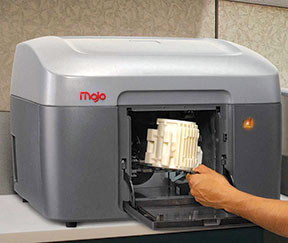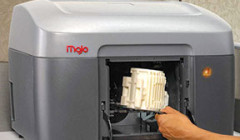3-D Printing
I watched a candle being made at the old Will & Baumer candle company once, using the dipping method. This is actually an extremely old method of creating a candle that requires nothing more than some sort of wick (a string or piece of rope will do), and a source of wax. The string is dipped repeatedly into the hot, liquid was, gradually building up layer after layer of wax until a sufficient diameter is reach. Voila, a candle.
 As I tried to understand the process of 3-D printing, I realized that candle dipping was probably as close as my non-technical mind was going to come to really “getting it.”
As I tried to understand the process of 3-D printing, I realized that candle dipping was probably as close as my non-technical mind was going to come to really “getting it.”
Properly termed, 3-D printing is a form of “additive manufacturing,” in which something (like the candle being dipped in wax to form layers) is added, layer by layer, to create an object. This is as opposed to “subtractive manufacturing,” which is more akin to sculpture. You remove bits and pieces to end up with a finished product. Or, assembly, in which you use a variety of subunits to create one new whole.
So in the case of 3-D printing, take one part manufacturing (sequential steps taken to create something new from raw materials or parts), and one part in-jet printing (a computer controls the location and density of ink deposited on a paper to create an image), and you have 3-D printing.
As much as 3-D printing has been talked and written about lately, the origin of the process is actually from the 1980s. So, that source of infinite wisdom that is Wikipedia tells us, “In 1984, Chuck Hull of 3D Systems Corporation, invented a process known as stereolithography, in which layers are added by curing photopolymers with UV lasers. Hull defined the process as a “system for generating three-dimensional objects by creating a cross-sectional pattern of the object to be formed.””
What was exciting about – and continues to be exciting about – 3-D printing specifically was scale and cost-to-produce. They were both manageable literally from home. So a hobbyist could design something that could be created using plastics and then literally print it, using an ink-jet type printer designed for 3-D printing.
 Using an open-source program like RepRap or Fab@Home, someone with a little technical knowledge could create a plastic replacement part for – oh, a printer, for example! You could “print” a plastic plate or fork. A Lego(TM) type block, or a toy.
Using an open-source program like RepRap or Fab@Home, someone with a little technical knowledge could create a plastic replacement part for – oh, a printer, for example! You could “print” a plastic plate or fork. A Lego(TM) type block, or a toy.
Today – and I mean, quite literally, today – you can go to Amazon, and for an investment of anywhere from about $500 to several thousand, you can have a 3-D printer (software usually included) delivered to your door. So whether you have an idea for the next gotta-have-it toy, or perhaps a revolutionary medical device, the limits are only those of your imagination.










